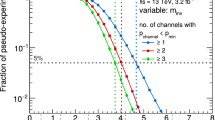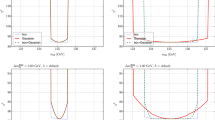Abstract
A lot of attention has been devoted to the study of discoveries in high energy physics (HEP), but less on measurements aiming at improving an existing theory like the standard model of particle physics, getting more precise values for the parameters of the theory or establishing relationships between them. This paper provides a detailed and critical study of how measurements are performed in recent HEP experiments, taking examples from differential cross section measurements with the ATLAS detector at the LHC. This study will be used to provide an elucidation of the concept of event used in HEP, in order to determine what constitutes an observation and what does not. It will highlight the essential place taken by theory-ladenness in order to produce observational facts, and will show how uncertainty and sensitivity estimates constitute an operational approach to robustness, inside the practice of science, avoiding potential circularity problem traditionally implied by theory-ladenness. This is in contrast to robustness analyses typically considered in the literature. A careful analysis of systematic uncertainty estimates and of statistical tests used to set empirical conclusions from the observations will however demonstrate that quantitative statements obtained from these statistical tests cannot be more than simple guiding arguments for the production of knowledge, but do not determine it. This indicates that the frontier between theory and observation is blurry and that the dichotomy theory-experiment should be revised.



Similar content being viewed by others
Notes
For example, we will discuss the measurement of a relationship between a certain kinematic variable, say the momentum of a jet, and the number of events having this feature in a process of interest. Such relationship corresponds to a law of probability called differential cross section.
“Statistical inference” is used here in the broad sense of an inference leading to results which can fluctuate based on statistical and systematic effects, and not necessarily in the sense of inference obtained from the use of specific statistical unbiased estimators.
For a more detailed summary of Hanson’s argument, see (Suppe 1977, pp. 154–156).
A jet is theoretically a collimated set of hadrons coming from quarks or gluons. Experimentally, it is a grouped set of calorimeter clusters, often matched to tracks that are representing a collimated set of hadrons.
All the figures are taken from the ATLAS public results page: https://twiki.cern.ch/twiki/bin/view/AtlasPublic.
Such a scenario is not crazy or even highly hypothetical; it can be easily achieved from Monte Carlo simulations used by particle physicists on a daily basis, and can even correspond to test beam studies performed on the wedges of calorimeters before the assembly of the whole detector.
Often referred to as “cuts” in physical analyses.
This could either be an electron and an electronic anti-neutrino, or a positron and an electronic neutrino.
Such sensitivity studies are typically carried on before a measurement gets produced, as it guides the design of the measurement. This is however not a necessary condition. Sometimes a measurement is designed with some other objectives in mind, and a different sensitivity study for some different underlying effects to be understood is performed later, thus adding to, or altering the initial sensitivity study, and the epistemic value of the results.
ATLAS papers such as (ATLAS 2012b) use the terminology “Bayesian unfolding method” to refer to this unfolding technique.
In case where such uncertainties would be considered negligible, statements justifying this must accompany the observational fact.
Note that the 5–10 % uncertainty due to jets includes the hadronic shower model discussed here and presented in Fig. 2, but also includes other uncertainties on jet calibration such as the dependence on the model of the processes used to derive calibration constants.
The meaning of such “best value” and to the probability assigned to the interval depends on the statistical approach adopted, as will be detailed below.
Note however that a systematic estimate can also be questioned. Crosschecks are often performed to determine if a systematic evaluation is reliable, underestimated or overestimated. The results of these cross checks will typically not get into the value of the final uncertainty estimate. These crosschecks are thus used to show that an uncertainty estimate is robust, and not to get the results of the measurement. They correspond to what Staley refers to as “second-order evidence in (Staley 1999).
Note that if the correlations between the experimental procedures are sufficiently small, a combination of the two results will be done, achieving an even better precision than each individual measurement results (Glazov 2005).
Results consisting in values like the mass of the top-quark are also used in a conjunction with theory elements to reach conclusions. For example, the top-quark mass is used in electroweak fits to test the consistency of the full SM, and the sensitivity to, say, non-standard Higgs. Theory is also used in the conclusions of searches, in order to set limits on various new physics models.
This example about PDF is completely made up for the sake of illustrating our arguments, and does not correspond to concrete situations about PDF measurements.
For a detailed discussion about p-values, see (Cowan 1998).
As for example in the case of the first Opera results Adam et al. (2012) about superluminous neutrino signal (the paper has been retracted by the collaboration).
For example the Dama/libra results (Bernabei 2010) on direct dark matter searches present a striking 8.9 s effects, but his not taken by the HEP community as a dark matter discovery, but as some yet to be determined signal that, similarly as expected from dark matter, feature an annual modulation.
References
Adam, T. et al. (2012). Measurement of the neutrino velocity with the OPERA detector in the CNGS beam using the 2012 dedicated data. in preparation for JHEP, arXiv:1212.1276 (hep-ex).
Agostinelli, S., et al. (2003). GEANT4: A simulation infrastructure. European Physics Journal, C70, 823–874.
ATLAS Collaboration. (1999). Technical design report: ATLAS detector and physics performance (Vol. 1), CERN/LHCC 99-14.
ATLAS Collaboration. (2010). Electron and photon reconstruction and identification in ATLAS: Expected performance at high energy and results at 900 GeV. ATLAS-CONF-2010-005.
ATLAS Collaboration. (2011). Jet energy measurement with the ATLAS detector in proton-proton collisions at \(\surd \)s = 7 TeV. European Physics Journal C, 73(3), 2304.
ATLAS Collaboration. (2012a). Observation of a new particle in the search for the Standard Model Higgs boson with the ATLAS detector at the LHC. Physics Letter B, 176, 1–29.
ATLAS Collaboration. (2012b). Study of jets produced in association with a W boson in pp collisions at sqrt(s) = 7 TeV with the ATLAS detector. Physics Review D, 85, 092002.
ATLAS Collaboration. (2012c). Measurement of the inclusive \(W\pm \) TeV with the ATLAS detector. Physics Review D, 85, 072004.
ATLAS Collaboration. (2013). Measurements of Higgs boson production and couplings in diboson final states with the ATLAS detector at the LHC. Physics Letter B, 726, 88.
ATLAS Collaboration. (2014). Pile-up suppression in missing transverse momentum reconstruction in the ATLAS experiment in proton–proton collisions at \({\rm sqrt}\{{\rm s}\} = 8\;{\rm TeV}\). ATLAS-CONF-2014-019.
Bai, Y., & Shelton, J. (2011). Measuring the invisible higgs width at the 7 and 8 TeV LHC. arXiv:1112.4496v2 (hep-ph).
Barlow, R. (2002). Systematic errors: Facts and fictions. MAN/HEP/02/01, arXiv:hep-ex/0207026.
Bell, S. A. (2001). A beginner’s guide to uncertainty of measurement. In: Measurement good practice Guide No 11(2), NPL Doc. Ref: PDB: 2284.
Bernabei, R., et al. (2010). New results from DAMA/LIBRA. European Physics Journal C, 67, 39–49.
Beauchemin, P. H., & Savard, P. (2010). Searches for new physics with jets-plus-missing-E(T) signatures using data-driven background estimates. Modern Physics Letter, A25, 1383–1401.
Blobel, V. (2010). Unfolding–Linear inverse problem. Note for the Terrascale workshop at DESY May 2010.
Bogen, J. (2014). Theory and observation in science. In: Edward N. Zalta (ed.) The Stanford Encyclopedia of Philosophy (Summer 2014 Edition).
Buckley, A. et al. (2011). General-purpose event generators for LHC physics. arXiv:1101.2599v1 (hep-ph).
Campbell, J. M., Huston, J. W., & Stirling, W. J. (2006). Hard interactions of quarks and gluons: A primer for LHC physics. arXiv:hep-ph/0611148v1.
Casadei, D. (2012). Reference analysis of the signal + background model in counting experiments. JINST, 7, P01012.
CMS Collaboration. (2012). Observation of a new boson at a mass of 125 GeV with the CMS experiment at the LHC. Physics Letter B, 176, 30–61.
Cowan, G. (1998). Statistical data analysis. Oxford: Oxford University Press.
Cowan, G. (2009). Statistics. Chapter 32 of the Particle Data Book edited by J. Beringer et al., Physical Review D, 86, 010001, (2012).
D’Agostini, G. (1995). A multidimensional unfolding method based on Bayes’ theorem. Nuclear Instrumental Method A, 362, 487.
Djouadi, A., Falkowski, A., Mambrini, Y., & Quevillon, J. (2012). Direct detection of Higgs-portal dark matter at the LHC. arXiv:1205.3169v3 (hep-ph).
Fernow, R. (1989). Introduction to experimental particle physics. Cambridge: Cambridge University Press.
Franklin, A. (1986). The neglect of experiment. Cambridge: Cambridge University Press.
Franklin, A. (1998). Selectivity and the production of experimental results. Archive for the History of Exact Sciences, 53, 399–485.
Galison, P. (1987). How experiments end. Chicago: University of Chicago Press.
Galison, P. (1997). Image and logic. Chicago: University of Chicago Press.
Glazov, A. (2005). Averaging of DIS cross section data. AIP Conference Proceedings, 792, 237.
Hanson, N. R. (1958). Patterns of discovery: An inquiry into the conceptual foundations of science. Cambridge: Cambridge University Press.
Hempel, C. G. (1965). Aspects of scientific explanation and other essays in the philosophy of science. New York: Free Press.
Joint Committee for Guides in Metrology. (2008). Guide to the expression of uncertainty in measurement. International Organization for Standardization. http://www.bipm.org.
Karaca, K. (2015). A study in the philosophy of experimental exploration: The case of the ATLAS experiment at CERN’s Large Hadron Collider. Synthese.
LHC Collaboration. (1995). The Large Hadron Collider: Conceptual Design. CERN/AC/95-05.
Lyons, L. (1989). Statistics for nuclear and particle physicists. Cambridge: Cambridge University Press.
Marciano, W. J. (2004). Precision electroweak measurements and the Higgs mass. XXIII SLAC Summer Institute, hep-ph/0411179.
Popper, K. (1934). The logic of scientific discovery. London: Hutchinson & co. (First English edition, 1959).
Prosper, H. B., & Lyons, L. (2011). Proceedings of the PHYSTAT 2011 workshop on statistical issues related to discovery claims in search experiments and unfolding, CERN-2011-006.
Ribon, A. et al. (2010). Status of Geant4 hadronic physics for thesimulation of LHC experiments at the start of LHC physics program. CERN-LCGAPP-2010-01.
Shapere, D. (1982). The concept of observation in science and philosophy. Philosophy of Science, 49(4), 485–525.
Sinervo, P. K. (2002). A Summary of the Treatment of systematics in the CDF Run I Top Quark Production Cross Section Measurement. CDF Public note 5920 (CDF/ANAL/CDF/PUBLIC/5920).
Sinervo, P. K. (2003). Definition and treatment of systematic uncertainties in high energy physics and astrophysics. In L. Lyons, R. Mount & R. Reitmeyer (Eds.), Proceedings of the conference on statistical problems in particle physics, astrophysics and cosmology, eConf:C030908 SLAC-R-703.
Staley, K. (1999). Golden events and statistics: What’s wrong with Galison’s image/logic distinction? Perspectives on Science, 7, 196–230.
Staley, K. (2004). The evidence for the top quark. Cambridge: Cambridge University Press.
Suppe, F. (1977). The structure of scientific theories (2nd ed.). Urbana: University of Illinois Press.
Acknowledgments
I would like to thank Michael Stoeltzner for having organized a workshop on the philosophy of the LHC in which I had fruitful discussions with him, as well as with Koray Karaca, Richard Dawid, and Ken Staley about various philosophical aspects of High Energy Physics. They also proposed relevant reading suggestions that helped me writing this paper. I would like to thank Tim Atherton and Diego Casadei for their helpful comments and suggestions regarding unfolding techniques and Bayesian statistics. I would finally like to thank Tim Atherton, as well as Philippe Labarre and Moon Duchin for their careful reading of the manuscripts and their numerous very useful suggestions.
Author information
Authors and Affiliations
Corresponding author
Rights and permissions
About this article
Cite this article
Beauchemin, PH. Autopsy of measurements with the ATLAS detector at the LHC. Synthese 194, 275–312 (2017). https://doi.org/10.1007/s11229-015-0944-5
Received:
Accepted:
Published:
Issue Date:
DOI: https://doi.org/10.1007/s11229-015-0944-5




